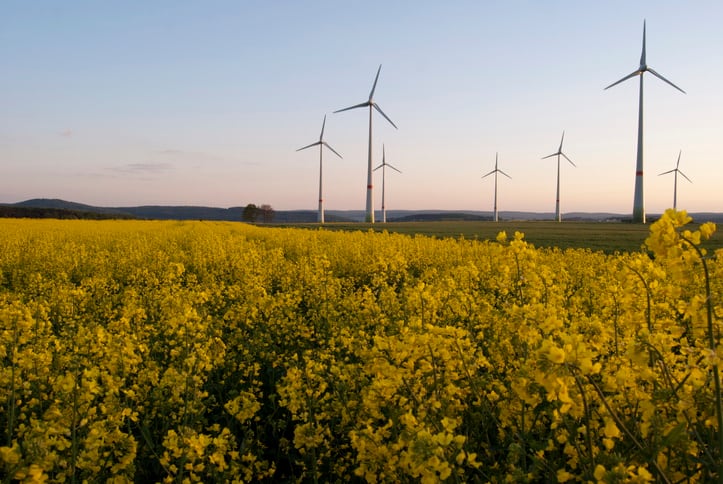PepsiCo is doubling its carbon reduction goal, targeting an absolute reduction of greenhouse gas (GHG) emissions across its value chain by more than 40% by 2030. Previously, the company had said it aimed to cut its GHG footprint by 20% in this timeframe.
The 2030 deadline is an important milestone on the company’s longer journey. PepsiCo has said it will be a net-zero company by 2040, one decade ahead of the deadline called for under the Paris Agreement.
According to PepsiCo Europe’s Supply Chain Vice President Chris Daly, this target is ambitious – but it is also non-negotiable.
“Unfortunately, the timetable is not really for debate. This is what companies now need to do,” he told FoodNavigator. “We can see the changes happening around us in terms of the warming of the planet and what's happening to crop resilience and availability. We are really talking about a resilience strategy for the business and for the planet at the same time.”
Given PepsiCo’s global scale and the complexity of its supply chain, achieving net zero across scopes one, two and three (from farm to fork) will be no mean feat. And Daly is all too aware of the scale of the challenge.
“This is an area of massive focus for us and we should recognise that it’s not an easy agenda. It will be massively challenging for us to do this. There will be times when we get it right and there will be times, no doubt, when we learn from getting it wrong. All of that is valuable.”
75% cut in CO2 from scopes one and two
Under PepsiCo’s 2030 roadmap, the company has said that it wants to eliminate 75% of scope one and two emissions – from its direct operations – by 2030.
Daly is confident of the company’s ability to deliver.
In particular, progress will be made by stepping up the switch to clean energy – which will account for around one-third of the reduction target within the group’s own operations.
“A big part of our agenda within that space is moving towards renewable energy. A third of our energy, thereabouts, is electricity. On electricity we have already started the journey towards 100% renewable energy.”
In Europe the Lay’s-to-Pepsi Max manufacturer has committed using 100% renewable electricity by 2022. Already 12 countries in Europe have achieved this goal and PepsiCo has installed renewable energy sources on-site at 13 of its facilities in the region. Solutions include windmills, solar, photovoltaic panels or biomass generators.

Another important area for progress is the ‘more challenging piece’ of replacing the fuel oil used within manufacturing sites – to power fryers, for instance. Daly does not expect to find a one-size fits all solution. “There we need to look at the different alternatives. It is about choosing the right solution, based on geographic locations, the category of business,” he revealed.
Progress to reduce emissions associated with transportation and cooling, Daly believes, will rely on a switch to low carbon fuels. Within vending cooling, he said, it isn’t about the machines themselves, which have been designed to be low energy usage. “The electricity that’s being used for those is, in many cases, non-renewable. So how do we work with our customers where the coolers and vending equiptment is based to move those towards renewably sourced energy?”
The answer: collaboration. “Everything in this agenda is about relationships.”
The challenge of scope 3: Supply chain emissions
Scope one and two emissions – generated in the company’s own operations and through purchased electricity, steam, heating and cooling – are areas that the company has direct control over.
The greater challenge is to cut scope three emissions, those that originate within the supply chain. But this is a challenge that PepsiCo must meet because scope 3 accounts for a staggering 91% of the group’s total carbon footprint.
“The bits that sit in the value chain are more complex to unlock because you have to work through partners and available supplies,” Daly explained.
Does this mean PepsiCo will use its financial clout and buying power to move the market?
Daly said the company is ‘reliant on changes within the industry’ to ‘make things work’. While he placed the focus on increased collaboration to speed a transition to low carbon models he did suggest that ‘ultimately’ commercial relations will come into play.
“Just as we want to move to renewable energy in our own facilities, it'll be important for our suppliers to be doing likewise. It'll be imp in agriculture that the companies that we are buying from are working with their direct growers to achieve the same kind of results as we are trying to achieve.
“Does this become part of the commercial relationship going forward? Fundamentally this is all about collaboration and people working on a common agenda. None of this happens unless people have common ways forward. It is through dialogue and ultimately through commercial relations with these parties that this will be done.
“Going forward, collaboration needs to work in every single dollar that we spend on inputs into our business in order for us to be able to realise the benefits we need.”
To set this common agenda, the industry is rallying around Science Based Targets – set by the SBTi to help drive climate action in the private sector. Daly observed this is helping to create a shared understanding and ‘common language’. “If everybody starts adopting Science Based Targets, everybody is using a common language and working towards the same goal, then we all benefit from everybody's collective efforts.”
‘Agriculture is at the centre of what we do’
As a food and beverage manufacturer, agricultural production is ‘at the centre’ of PepsiCo’s operations. It is also a sector that is, on the one hand, a significant contributor to carbon emissions while, on the other, also being greatly exposed to the risks associated with climate change.
PepsiCo has long worked to support sustainable agricultural practices. However, the company now intends to ‘advance to regenerative agriculture’, Daly revealed. This approach includes ‘multiple dimensions’ from soil health to biodiversity.
Again, Daly stressed the importance of collaboration. “Within our direct agriculture we have very strong relationships with our growers. Over a period of time, those relationships seen us bring them new ways of looking at things and also them bringing us new ways of looking at things. It’s a very symbiotic relationship we have, which leads to a better system.”
Precision agriculture is one area that PepsiCo is backing as offering the opportunity to minimise resource use while maximising yield and the company is working with its direct suppliers to pilot potential ag tech solutions.

“At the end of the day, you've got to prove that this actually works. It is through that partnership of exploring and exploiting the outcome of the solution that ultimately, we get to the right place.
“One of the things people talk about in this space is how do you motivate people to do the right thing? The reality is when everybody wins through the process, it becomes really easy to go and do it. That is typically the way our sustainable agri programme has developed over a number of years, it simply has worked well for everybody.”
The importance of circularity
One recent example of this approach, currently in the pilot phase, is PepsiCo’s development of a fertiliser produced from potato processing biproducts.
Using carbon capture technology developed by British clean-tech firm CCm Technologies potato peelings leftover from making Walkers crisps in PepsiCo’s Leicester factory will be transformed into low-carbon fertiliser and returned to farms where potatoes for our crisps are grown across the UK.
“We are effectively taking the waste from our manufacturing facilities and using that as the basis for the fertiliser,” Daly elaborated. “Circularity is at the heart of everything. The fertiliser example is exactly that circularity happening where waste from the peel of potatoes is going back to make the fertiliser that grows the next potato.”
Circularity is already embedded in many of PepsiCo’s production models, Daly noted. Waste starch from potato processing is used to create tape for boxes, waste vegetable oil is used in either manufacturing, packaging or processing. And, of course, alongside reduction efforts, the company is working to support circular models for plastic packaging.
“You can start building all these incremental circular activities and it is through that process that you start seeing real benefits coming though. Circularity is at the heart of everything we do over the next ten years.”
Planet versus profit?
As PepsiCo steps up its efforts to drive down GHG emissions, what impact will this investment have on the bottom line?
“There is a real balance there. We are still running a business. We have financial commitments that we intend to stand by in spite of taking on this agenda. What it does mean is we need to reallocate resources in many cases and try to find ways of fitting this agenda within our business,” Daly told this publication.
Nevertheless, he also stressed the urgency with which companies like PepsiCo must act. “This is now an agenda that needs to be done, there isn't really a choice. You have to be able to find the right way within your algorithm to be able to bring it to life. That's part of successful implementation. It's not only delivering for the planet, it’s delivering for the planet while you also deliver for the overall business.”
Indeed, he stressed, sustainability is not just an environmental imperative – it has become a business imperative as well, with customers and consumers increasingly focusing on carbon footprint. Environmental consumerism is no longer a niche concern.
“There has been a massive shift in the last 18 months on awareness of climate and that is going to benefit the speed at which industry moves.
“It's very similar to what we saw on plastic packaging four and a half years ago. Consumers are more and more aware; they know it is important. And, just as we saw on plastic packaging, once consumers become aware its really helpful to start driving companies in the right direction.”
Daly sees this shift within the bigger-picture debate around the future of the food system as a whole. “The food system has broken effectively... The evolution of food development over the last 40 years has got to a point where it no longer works. It's not that intelligent, it’s not that equitable and it’s certainly not that gentle on the planet.
“We have to go back and fix that. We need to make it a much more equitable food system. We need to address the impacts that current food production is having on the environment. Unless we get back to circularity and regeneration, we're not going to have a system that can feed the planet.”




